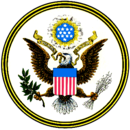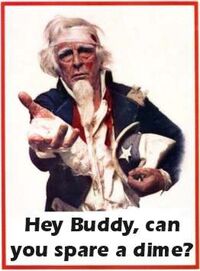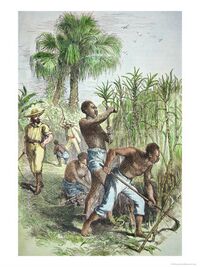US National Debt
| Part of a series on |
| Politics of the United States |
|---|
 |
The current United States National Debt is sixteen trillion, nine hundred and six billion, five hundred and forty two million, two hundred and thirteen thousand, nine hundred and four dollars... five dollars, six , seven, nine.... By the time of the next election it is estimated it will have grown to $60,000 per citizen, or almost seventeen trillion dollars – a statistic that pleases no one except the mathematicians kept in work inventing ever larger numbers.
One of the great mysteries of the world is how three hundred million people managed to run up quite such an enormous liability in only 250 years while still allowing their poor to go without education, housing or health-care. Evidently, a good deal of money was spent on vodka and cocaine but a considerable proportion was also frittered away spreading its principals across the world; upholding democracy by bank-rolling dictators of oil-bearing countries and supporting freedom of speech by carpet-bombing small tropical nations with opposing economic ideas. But just how did the United States manage to convince lenders to provide it with such eye-wateringly huge amounts of cash, and how did they successfully service such a large deficit for so long that those lenders are now too scared to stop lending for fear that the US may default on their existing debts?
The Early Years
In 1775 the National Debt of the United Kingdom stood at an unprecedented £130 million, largely incurred in shooting Frenchmen and dispossessing the native peoples of New England. At the same time the population of the thirteen American colonies made up 25% of the total “British” populace of 8.2 million, making the indebtedness of the average American sixteen pounds, five shillings and tuppence.
Rightly realising that Britain's defeat of both France and Spain and the successful introduction of smallpox into Amer-Indian tribes had removed all physical threats to the colonies, Benjamin Franklin had a moment of revelation. Why not also remove the financial threat to the colonies by simply opening for business under a new name? Thus the American Revolution began in a fit of penny-pinching and by 1783 had successfully avoided its £32 million share of British debt by becoming fully independent, running up a mere $43 million debt in the process to cover the costs of wig-powder, tricorn hats and copies of the sheet-music to Yankee Doodle Dandy.
Having fought a war to avoid tea-duty one of Congress’s first acts was to introduce taxation to cover its spiraling arrears. In a foreshadowing of future fiscal policy, Secretary of the Treasury, Alexander Hamilton, imposed duties too low to cover repayment and allowed debt to rise swiftly to $77 million. He is famously quoted as saying “A national debt will be to us a national blessing”[1]. Other, less cited Alexander Hamilton quotations include “Quick, hide behind the curtains and pretend we’re not in - the rent-collector’s here again”[2], and “If we change our name to the Amalgamated Counties of Columbia they’ll never find us in the phone book.”[3]
Expanding nation, expanding debt
The late eighteenth and early nineteenth centuries saw a great extension of slavery within the United States as governments sought ways to increase productivity without bothersome wage bills. Consequently, the National Debt did not increase greatly until 1803 when Thomas Jefferson rashly purchased 828,000 square miles of territory west of the Mississippi after a heavy night of Cognac at the French Embassy.
This purchase proved greatly controversial, with a number of leading authorities feeling it was unconstitutional and many more believing that three cents an acre for Louisiana constituted very poor value for money. But how to pay for half a continent of swamp, in-breeds and alligators? The answer was, as always, to seek help from the bank. In return for a thirty year agreement not to sub-let or modify Alabama without consent and a promise to repaint and carpet Missouri, America was advanced $11,250,000 at a fixed rate of 4% pa.
Despite this, an ever expanding tax-base meant that by 1833 the principal sum had been repaid and the nation enjoyed a riotous mortgage-burning party in Arkansas, inviting Canada and Mexico to the barbeque so that they might see what could have been achieved had they had the foresight to join the union. But hardly had Haiti thrown up in the fridge and gone home wearing Puerto Rico’s coat than it was found that America’s lawyers had botched the legal survey prior to exchange of contract and that France had not owned the freehold on the territory - having merely squatted in property rightly belonging to the Muskogee people. Fortunately, US government officials dealt with the potentially tricky legalities by largely wiping out the tribe at the Battle of Horseshoe Bend and making an ex gratia payment of three chests of beads, twelve barrels of fire-water and a retirement complex in Florida to the survivors.
Having at least partially learned its lesson, the United States continued to expand without adding to its debt burden. Treasury officials realised that it was far more cost-effective to simply steal Texas from its previous owner in 1845 and other expansions were equally frugal; with the USA receiving Oregon from Britain in part-exchange for a few thousand tons of Albertan snow and some baseball cards, and Florida from Spain as a birthday present. Despite opposition from all sides President Millard Fillmore agreed to accept California from Mexico as a dare until Congress outlawed further such adventures in 1851, though this did not prevent Andrew Johnson winning Alaska from Tsar Alexander in a card game, or William McKinley from overseeing the acquisition of Hawaii as a joke.
Civil War (1861-1865)
In 1860 U.S. Government debt had been paid down to $64.8 million with only the cost of developing the Stetson hat preventing it falling below the psychologically important $60 million mark. However, disagreements on the meaning of liberty were threatening to forestall future progress. With the southern states insisting on their constitutional freedom to enslave and brutalise sections of its own population and the northern states upholding their right to deny their southern cousins the liberty to secede there seemed only one solution. In an effort to avoid a repeat of the disgraceful scenes witnessed in the Senate that year, all parties agreed to settle their differences like gentlemen. And so began a four year program of reducing the population of fighting-age men through a series of culls at Gettysburg, Bull Run and Manassas in the hope of returning to a more peaceful way of life with fewer aggressive youths to fuel national disharmony.
But even carnage is not free. Northern troops could not mow down Confederate rebels without ammunition to feed the Gatling guns, and the southern states faced financial pain trying to equip an army of over 100,000 men with pitchforks, while the royalties payable to the composer of the Rebel Yell consumed up to thirty percent of the Confederate budget. Consequently, debt grew quickly on both sides.
The financial cost of the war may have totaled as much as $5.2 billion and the Government had to come up with new ways to pay. The first and most successful method was what is now termed “Check fraud” but was then quaintly titled the “Legal Tender Act” which allowed government to issue paper money and then borrow it back. Previously, banks had printed their own money based on how much gold they held in their vaults. After 1862, this outdated system was replaced by government-printed greenbacks, backed by promises to pay at some unspecified future date as President Lincoln had left his wallet in his pants when dropping them off at the Chinese laundry and wasn't sure when he’d get it back.
1863 saw the National Bank Act which introduced a truly nationwide banking system for the first time and then suggested that it might be a good idea for the banks to cough up a few bucks to “make sure there wasn't a fire – you know how these wooden buildings go up.” As a result of these measures and the enormous cost of maiming its youth, government debt had reached $2.6 billion dollars by war’s end, an increase of 4000% from five years previously and this after the half of the debt had been written off as it had been issued in worthless Confederate dollars.
The Twentieth Century
The latter half of the Nineteenth century had seen the debt slowly paid down again as a series of Presidents made use of so-called “Cash-4-Gold-Rush” companies which paid millions of dollars for parcels of land that previous administrations had promised to Native Americans “in perpetuity”. As the Native Americans had brazenly failed to use the land for anything more productive than living on and raising children in, it was felt better to relocate them to dustier, less mineral-rich territories where they would have better access to Peyote, cheap alcohol and rattlesnakes.
In both early twentieth century global conflicts America took the pragmatic approach of selling arms to both sides for several years before joining in the fun to ensure a major share of any spoils. As a consequence, National Debt fell between 1914 and 1917 only to rise to $25 billion by November 1918 as the American Expeditionary forces learned that turning Belgium into the muddy hole it is today required millions of tons of expensive high explosives.
The subsequent economic boom of the Roaring Twenties saw the government engaging in the sort of Un-American activities that would later see Senator McCarthy dribble with rage, running a succession of budget surpluses and paying down the debt to a mere $17 billion by the time of the Wall Street Crash of 1929. Further Un-American activities followed in the form of nationwide welfare programs and the expansion of social services. But where could the government borrow the huge sums needed at a time when banks were closing across the continent?
The answer came to President Franklin D. Roosevelt in the form of a small printed flyer pasted in a telephone kiosk. “Honest Don’s Family Loan-Sharking” promised unlimited funds at a mere 2000% interest and a monthly visit from one of his “nephews” and his Louisville Slugger. Roosevelt immediately took the opportunity to borrow an additional $30 billion as the promise to break his legs if he didn't pay up seemed less threatening after the ravages of Polio.
With the debt up to $49 billion by 1941 Roosevelt’s insistence that he had the money but it had slipped down the back of the couch seemed ever more threadbare. In February he once again delayed payment, claiming to need the money to bury a much loved family pet. Honest Don declared himself fed up with excuses and sent the boys round with a message that any future prevarication would result in Eleanor Roosevelt being given a concrete overcoat.
With no alternative FDR shamelessly picked a fight with Japan, in the knowledge that Germany and its ally Italy would soon declare war. This allowed him to have Honest Don interred as an enemy alien, his nephews drafted into the army and an additional $210 billion in loans secured from other Honest Don’s and Baby-face Schickelgruber's across the country.
The end of World War II saw another economic boom which US governments took as the perfect time to increase its level of indebtedness in order to pay for re-modelling South East Asia from the air, and to build enough atomic weaponry to destroy several planets – successfully forestalling planned invasions by both Mars and Uranus. By the mid 1970's debt reached an all-time high of $800 billion just in time for the policy of buying fleets of ever larger, less efficient motor vehicles and exporting their production to Japan to really pay-off.
As other nations continued to capture US market-share across the globe they found themselves in need of opportunities in which to invest their new-found wealth. As ever, America had the answer and it is estimated that Chinese government agencies alone now own over $2 trillion of the National Debt. Thus America, by a mixture of luck and shrewd judgement, has finally found itself able to indulge in its constitutional right to pursue happiness rather than waste time working. Consequently, providing Americans continue to spend other peoples’ money on goods manufactured elsewhere the world economy can continue to expand indefinitely, spreading peace, prosperity, and pollution across the planet.
Footnotes
| Featured version: 7 September 2013 | |
| This article has been featured on the main page. — You can vote for or nominate your favourite articles at Uncyclopedia:VFH. | |






